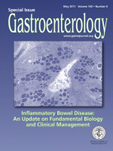
英国的一项新研究发现,对于已经患有巴雷特食管症的人来说,吸烟会大幅增加其最终患食管癌的风险,研究人员因此呼吁这类“风险人群”戒烟。
巴雷特食管症是由于胃液反流入食管,其中的酸性物质损伤食管下端的表皮组织所致,其表现为食管下端被不正常的柱状上皮覆盖。已有研究表明,巴雷特食管症患者出现食管癌的风险比普通人高出数十倍。
英国贝尔法斯特女王大学等机构的研究者在新一期美国学术刊物《胃肠病学》上报告说,他们调查了3000多名巴雷特食管症患者,结果发现那些抽烟的病人最终出现食管癌的风险会更高,其风险是不抽烟患者的两倍多。
研究人员海伦·科尔曼说,这项研究调查了巴雷特食管症患者的多种生活习惯,结果确认吸烟是导致该病部分患者最终出现食管癌的最大风险因素。这种风险的上升与吸烟多少的关系不大,不论一天是吸几盒烟还是只吸几支烟,患食管癌的风险都会大幅上升。
报告指出,这是迄今规模最大的针对巴雷特食管症患者最终癌变风险的研究,所得出的结论促使研究人员呼吁,巴雷特食管症患者应该做到完全戒烟。

 Tobacco Smoking Increases the Risk of High-Grade Dysplasia and Cancer Among Patients With Barrett's Esophagus
Tobacco Smoking Increases the Risk of High-Grade Dysplasia and Cancer Among Patients With Barrett's Esophagus
Helen G. Coleman, Shivaram Bhat, Brian T. Johnston, Damian McManus, Anna T. Gavin, Liam J. Murray
Background & Aims Esophageal adenocarcinoma arises from Barrett's esophagus (BE); patients with this cancer have a poor prognosis. Identification of modifiable lifestyle factors that affect the risk of progression from BE to esophageal adenocarcinoma might prevent its development. We investigated associations among body size, smoking, and alcohol use with progression of BE to neoplasia.
Methods We analyzed data from patients with BE identified from the population-based Northern Ireland BE register, diagnosed between 1993 and 2005 with specialized intestinal metaplasia (n = 3167). Data on clinical, demographic, and lifestyle factors related to diagnosis of BE were collected from hospital case notes. We used the Northern Ireland Cancer Registry to identify which of these patients later developed esophageal adenocarcinoma, adenocarcinomas of the gastric cardia, or esophageal high-grade dysplasia. Cox proportional hazards models were used to associate lifestyle factors with risk of progression.
Results By December 31, 2008, 117 of the patients with BE developed esophageal high-grade dysplasia or adenocarcinomas of the esophagus or gastric cardia. Current tobacco smoking was significantly associated with an increased risk of progression (hazard ratio = 2.03; 95% confidence interval, 1.29−3.17) compared with never smoking, and across all strata of smoking intensity. Alcohol consumption was not related to risk of progression. Measures of body size were infrequently reported in endoscopy reports, and body size was not associated with risk of progression.
Conclusions Smoking tobacco increases the risk of progression to cancer or high-grade dysplasia 2-fold among patients with BE, compared with patients with BE that have never smoked. Smoking cessation strategies should be considered for patients with BE.
文献链接:https://www.gastrojournal.org/article/S0016-5085(11)01508-3/abstract







